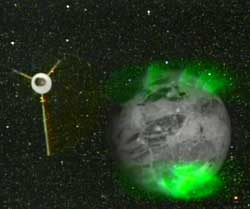
Galileo has dark encounter with Jovian moon Ganymede
SPACEFLIGHT NOW
Posted: December 28, 2000
| |

Galileo makes its flyby of Ganymede while in eclipse by Jupiter as shown in animation. Photo: NASA TV/Spaceflight Now
|
NASA's intrepid Galileo spacecraft zips past Ganymede on Thursday for a unique close encounter that will provide a chance to study the faint auroral glows on the solar system's largest moon.
When Galileo makes its nearest pass at 0825 GMT (3:25 a.m. EST), Ganymede will have slid into the shadow of Jupiter, giving scientists an excellent chance to examine the glows that would be overwhelmed by sunlight at other times.
"By timing the encounter to happen while Ganymede is in eclipse, we're putting Galileo in the right place at the right time to see auroras," said Dr. Eilene Theilig, deputy project manager for Galileo at NASA's Jet Propulsion Laboratory, Pasadena, Calif.
In its 29th orbit of Jupiter since arrival in December 1995, the durable spacecraft is on course to pass about 2,300 kilometers (about 1,430 miles) above the surface of the darkened moon.
Galileo last visited Ganymede in May, when it passed within about 800 kilometers (about 500 miles) of the surface, collecting information that scientists announced this month they see as evidence for a liquid ocean hidden under Ganymede's surface. Thursday's flyby is a special opportunity to study what's above the surface.
| |

Animation shows the auroral glows on Ganymede as Galileo has its close encounter. Photo: NASA TV/Spaceflight Now
|
With direct sunlight blocked by Jupiter, scientists expect to see shimmering auroras on Ganymede, comparable to Earth's Northern Lights. "The auroral glows we plan to observe occur because Ganymede has a very tenuous atmosphere of gases," said Dr. Torrence Johnson, Galileo project scientist at JPL. "When these gases are hit by electrons from Jupiter's radiation belts, they glow. It's similar to what goes on in a fluorescent light bulb when you turn on the electricity."
NASA says studying Ganymede's aurora could provide information about the chemical makeup of gases in the moon's atmosphere and also about its magnetic field.
Ganymede is not only the largest moon in our solar system, it is the only one known to have its own internally generated magnetic field. Paths of electrons approaching Ganymede from Jupiter's radiation belts are determined by lines of magnetic force, so the location of the glows triggered by those electrons reveals something about the shape of the magnetic field around the moon, Johnson said.

Is Ganymede harboring an ocean beneath its icy crust like Europa? This image, taken by Galileo, shows a same-scale comparison between Arbela Sulcus on Jupiter's moon Ganymede (left) and an unnamed band on Europa (right). Arbela Sulcus is one of the smoothest lanes of bright terrain identified on Ganymede, and shows very subtle striations along its length. Arbela contrasts markedly from the surrounding heavily cratered dark terrain. On Europa, dark bands have formed by tectonic crustal spreading and renewal. Bands have sliced through and completely separated pre-existing features in the surrounding bright ridged plains. The scarcity of craters on Europa illustrates the relative youth of its surface compared to Ganymede's. Unusual for Ganymede, it is possible that Arbela Sulcus has formed by complete separation of Ganymede's icy crust, like bands on Europa. Photo: NASA/JPL/DLR/Brown University.
|
Galileo's trajectory for the Ganymede flyby gives the orbiter an exposure to Jupiter's intense radiation belts, said Jim Erickson, project manager for Galileo at JPL. With extensions to its original two-year mission, Galileo has survived three times the cumulative radiation dose it was designed to tolerate.
Some of its 12 scientific instruments have been impaired by the radiation to varying degrees, but the spacecraft is still returning valuable scientific information. The effects of additional exposure next week cannot be predicted with certainty, Erickson said.
Galileo is collaborating with NASA's Cassini spacecraft on several studies of Jupiter and its surroundings this fall and winter, while Cassini passes Jupiter for a gravity boost toward its 2004 appointment with Saturn.

|
 |
 |
 |
Video vault
 NASA animation shows the Galileo space probe making a close flyby of Jupiter's moon Ganymede. The moon is in eclipse by the giant gas planet during Galileo's encounter.
NASA animation shows the Galileo space probe making a close flyby of Jupiter's moon Ganymede. The moon is in eclipse by the giant gas planet during Galileo's encounter.
PLAY (307k, 32sec QuickTime file)

 With the sun behind us, this animation clips shows Ganymede slipping into the eclipse, which makes its auroral glow visible as Galileo passes closest to the moon.
With the sun behind us, this animation clips shows Ganymede slipping into the eclipse, which makes its auroral glow visible as Galileo passes closest to the moon.
PLAY (374k, 37sec QuickTime file)








|

